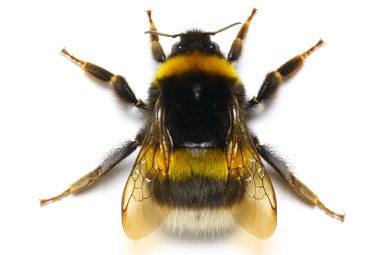
Bumble bees are considered to be a beneficial insect because they are responsible for pollinating a large variety of plants and crops. However, their aggressive nature can make them problematic if they build their nests too close to homes or businesses. There are approximately 45 species of bumbles bees living in the United States and in Canada.
| Pest Identification | |
|---|---|
| Recognition | Bumble bees are predominantly black in color with yellow stripes. Some species may have orange or red stripes. They are oval in shape with an overall very fuzzy appearance. Adult workers can grow to be ½ to 1 inch in length. The queens are slightly larger, growing to be ¾- 1 inch or more. Females have a stinger and a more pointed abdomen while males do not have a stinger and have a more rounded abdomen. |
| Biology | The bumble bee’s life cycle includes eggs, larvae, pupae, and adults. Each year a new nest and colony is developed. In the spring a fertile queen will emerge from her overwintering spot and finds a suitable place to build this year’s new nest in. Once the nest is built she lays her eggs and gathers nectar and pollen to feed the larvae once they hatch. After the eggs hatch (16-25 days) the larvae go through several molts until they become the first generation of workers for the colony. These workers then help to increase the size of the nest and gather food for new members of the colony. The queen continues to lay eggs and thus increasing the colony’s size throughout the summer. In late summer she starts to produce males and future queens. In the fall the males and new queens emerge from the nest to mate and the new fertile females go and find a safe place to overwinter in, while the males and rest of members of the colony die with the cold winter weather. In the spring the new queens emerge once again to continue the bumble bee’s life cycle. |
| Habits | Bumble bees typically build their nests in safe areas below the ground or as close to ground level as possible. Typical nesting sites include abandoned: Underground burrows of other animals, Under piles of grass clippings, In or under leaves and compost, Underneath woodpiles, In open areas underneath exterior siding of buildings. Bumble bees will defend their nests aggressively. They buzz very loudly and chase the perceived threat away from the nest. Bumble bees can repeatedly sting their victims and their sting is one of the most painful stings. Like other stinging insects, the venom from a bumble bee can cause a severe allergic reaction in some individuals that may require medical attention. |
| Prevention | Preventing bumble bees from choosing your property to nest on can be very difficult to accomplish. It is impossible to dictate whether a queen will choose your property or your home for her next nest. The best way to prevent problems with bumble bees on your property is to contact a professional pest control expert to come and remove them if they have become a safety issue for you and your family. If there a nest is on your property but it is out of the way of your family than it is best to leave it alone since they are beneficial insects and pollinators. |
| Professional | If a bumble bee nest has become problematic on your property you should contact Rottler. One of our experienced pest management professionals will come to your property and perform an inspection and then begin treatment to eliminate the bumble bee nest from your property. A Rottler technician will liberally inject residual insecticide dust into the nest entrance. For structural nests, the cavity will be treated with a dust or aerosol formulation but the entrance will not be sealed until the colony has been destroyed. Treated structural nests will be removed, if accessible, to prevent future problems with secondary pests, such as dermestid beetles, wax moths, and psocids. |

